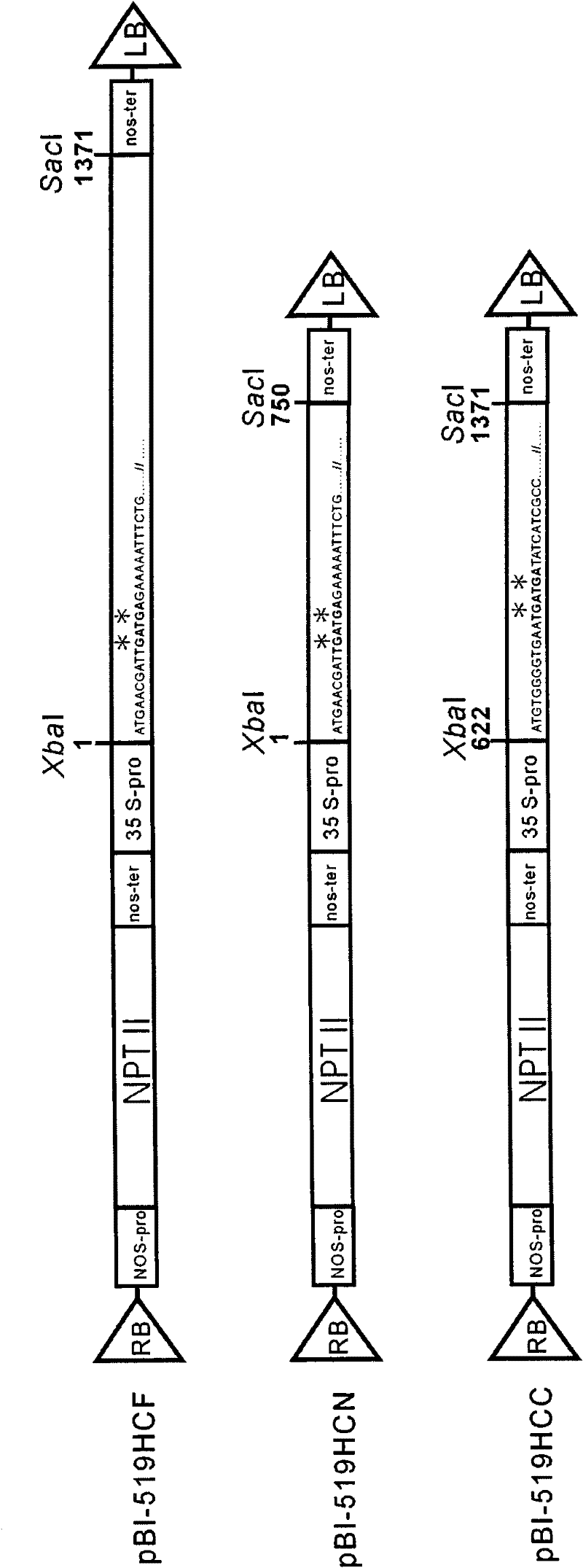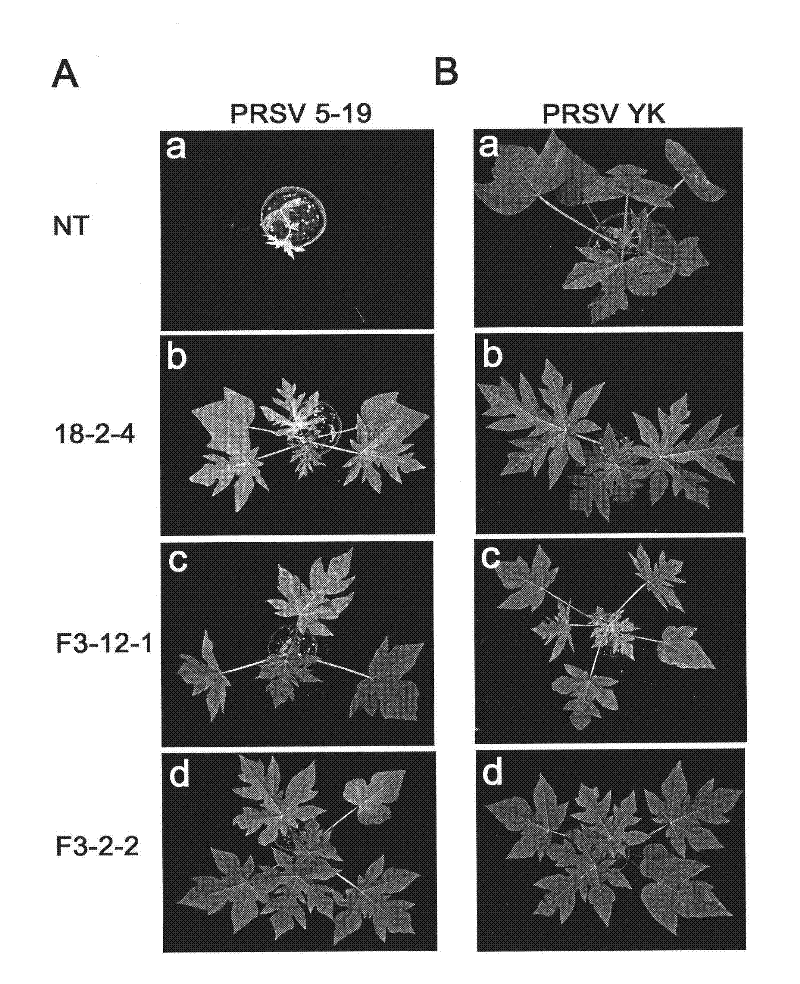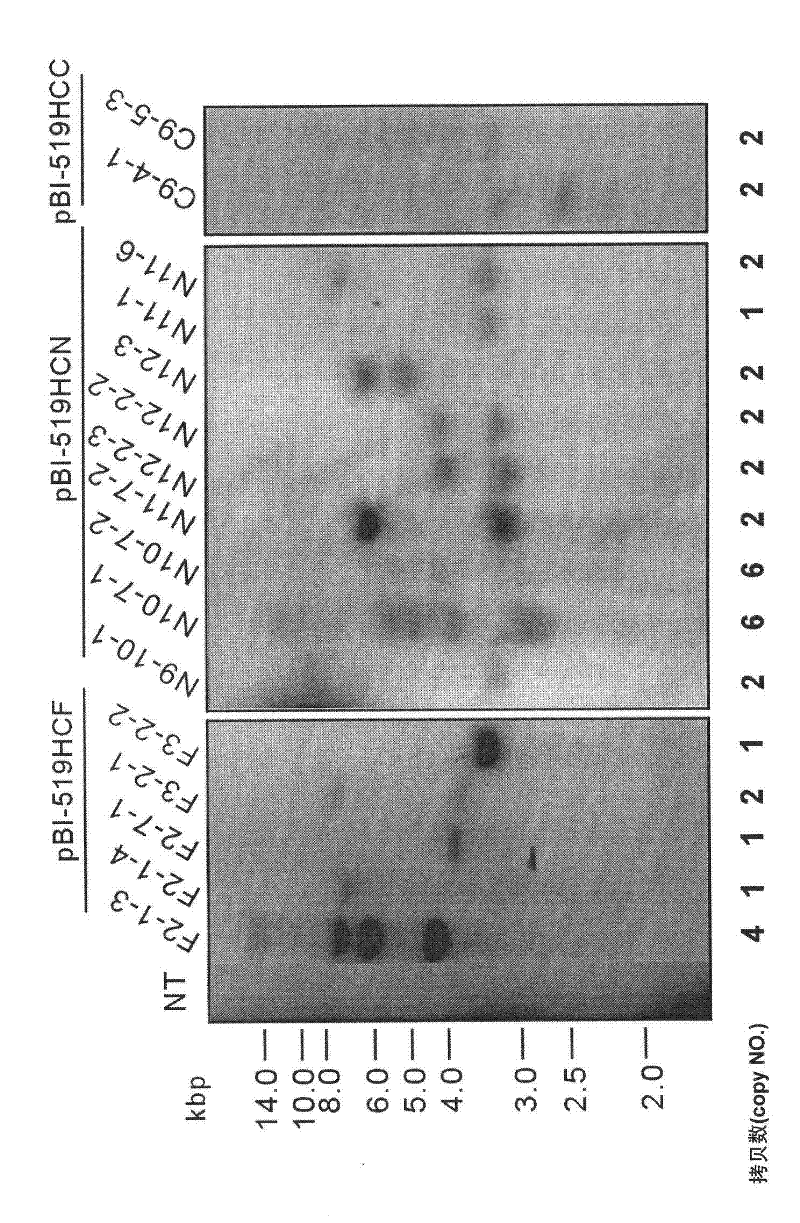Gene transfer vector comprising papaya ringspot virus auxiliary component protease gene and application thereof for providing broad-spectrum virus resistance in crops
An auxiliary component, the technology of ringspot virus, is applied in the direction of plant gene improvement, application, genetic engineering, etc. It can solve the problems of inability to function, failure of transgenic papaya, etc., and achieve the effect of not relying on homologous resistance
- Summary
- Abstract
- Description
- Claims
- Application Information
AI Technical Summary
Problems solved by technology
Method used
Image
Examples
Embodiment 1
[0051] Embodiment 1. Preparation of the non-translational construct of the auxiliary component protein HC-Pro gene
[0052] The HC-Pro gene (SEQ ID NO: 8) of PRSV 5-19 was amplified by RT-PCR and constructed in Vector (Invitrogen), constructed in a non-translational manner, designed a set of specific primers: 519HCStopA (5'-CGCATGAACATGC TCTAGA TGAACGATTGATGAGAAAAAATTTCTG-3') (SEQ ID NO: 1) and 519HCSacB (5'-GTGGTTGGATCAAA GAGCTC ACCGACAATGTAGTGTTTCATTTC-3′) (SEQ ID NO: 2), two stop codons (TGATGA), XbaI restriction site ( TCTAGA ) and add one more base (T) to shift the entire protein reading frame, and the downstream primer (519HCSacB) designed a SacI restriction site ( CTCGAG ), the HC-Pro full-length gene (after 1371bp) on the TOPO carrier was amplified by PCR to 1372bp (SEQ ID NO: 5) by adding a base T, and loaded with the same restriction enzyme after digestion with XbaI and SacI restriction enzymes Digested pBI121 (Clontech, CA), and finally obtained the non-tran...
Embodiment 2
[0056] Embodiment 2. Preparation of transgenic papaya
[0057] In order to shorten the time for transfer and screening, a set of rapid papaya transgenic methods (Kung et al., 2009) developed by the applicant's laboratory in recent years was used. Papaya bottle seedling propagation in laboratory tissue culture system. In Murashige-Skoog medium containing 0.02mg / lα-naphthaleneacetic acid and 0.2mg / l benzylaminopurine (MSNB ) were cultured for two weeks, transferred to MS medium containing indole-3-butyric acid (IBA), and induced root primordia to occur after one week of dark culture at 28°C. At this time, it was in the root induction period (root induction period) [with Plant growth hormone dependent (Auxin dependent)], and then moved to pearlite containing 1 / 2 volume of MS to prolong root development, at this time in the root development period (Root development period) [has nothing to do with plant growth hormone (Auxin independent )], two weeks later, the root tip was excis...
Embodiment 3
[0059] Example 3. Detection of quasi-transgenic plants by polymerase chain reaction
[0060] Extract the genomic DNA of the plant to be transgenic as a template, and use the pBI-HCF, pBI-HCN and pBI-HCC constructs obtained above as the positive control group, and use the specific primer pair designed according to the sequence of the target gene HC-Pro , which includes 519HCStopA / 519HCSacB, 519HCStopA / 519HCSacA, and 519HCStopB / 519HCSacB primer pairs, respectively performing polymerase chain reaction (PCR) amplification on the HC-Pro full-length gene, N-terminal fragment and C-terminal fragment. On the other hand, the nptII gene was amplified with the primer pair nptII 5' primer 5'-CCCCTCGGTATCCAATTAGAG-3' (SEQ ID NO: 9) and nptII 3' primer 5'-CTGGAGTTCTTCGCCA-3' (SEQ ID NO: 10), and expressed as PCR products were analyzed by gel electrophoresis. According to the analysis of the results of gel electrophoresis, the plants with the expected fragments amplified by the aforemention...
PUM
 Login to View More
Login to View More Abstract
Description
Claims
Application Information
 Login to View More
Login to View More - R&D
- Intellectual Property
- Life Sciences
- Materials
- Tech Scout
- Unparalleled Data Quality
- Higher Quality Content
- 60% Fewer Hallucinations
Browse by: Latest US Patents, China's latest patents, Technical Efficacy Thesaurus, Application Domain, Technology Topic, Popular Technical Reports.
© 2025 PatSnap. All rights reserved.Legal|Privacy policy|Modern Slavery Act Transparency Statement|Sitemap|About US| Contact US: help@patsnap.com



